2013 DACIA SANDERO warning
[x] Cancel search: warningPage 65 of 146
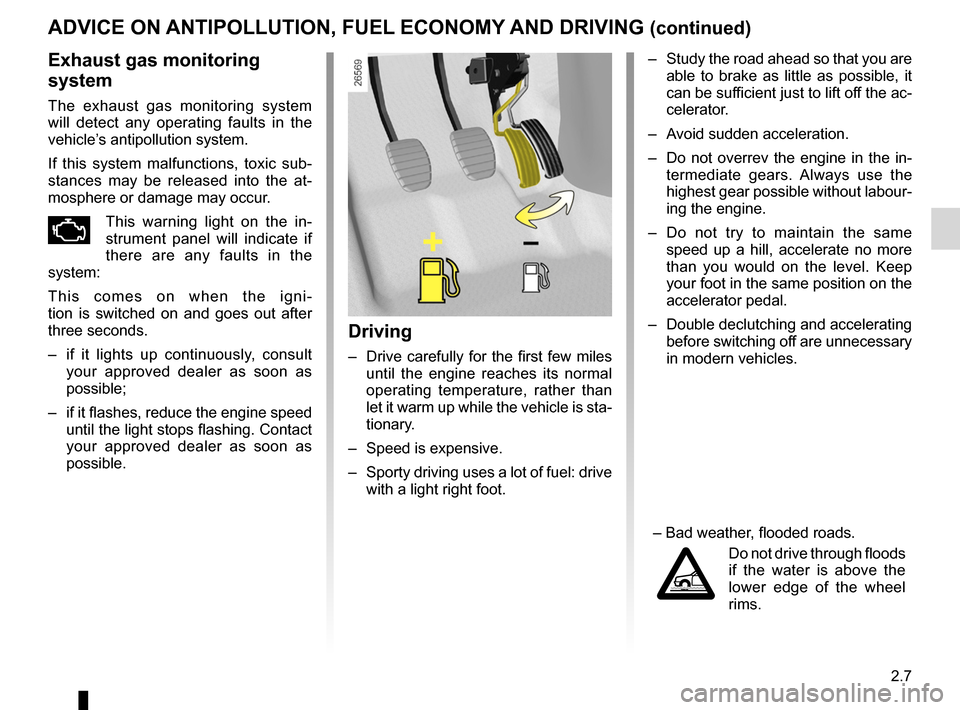
JauneNoirNoir texte
2.7
ENG_UD5485_1Conseils antipollution, économies de carburant, conduite (U90 - Daci\
a)ENG_NU_817-2_NU_Dacia_2
– Study the road ahead so that you are able to brake as little as possible, it can be sufficient just to lift off the ac- celerator.
– Avoid sudden acceleration.
– Do not overrev the engine in the in
- termediate gears. Always use the highest gear possible without labour- ing the engine.
– Do not try to maintain the same
speed up a hill, accelerate no more than you would on the level. Keep your foot in the same position on the accelerator pedal.
– Double declutching and accelerating
before switching off are unnecessary in modern vehicles.
– Bad weather, flooded roads.
Do not drive through floods if the water is above the lower edge of the wheel
rims.
Exhaust gas monitoring
system
The exhaust gas monitoring system will detect any operating faults in the vehicle’s antipollution system.
If this system malfunctions, toxic sub- stances may be released into the at- mosphere or damage may occur.
ÄThis warning light on the in- strument panel will indicate if there are any faults in the system:
T h i s c o m e s o n w h e n t h e i g n i- tion is switched on and goes out after three seconds.
– if it lights up continuously, consult
your approved dealer as soon as possible;
– if it flashes, reduce the engine speed
until the light stops flashing. Contact your approved dealer as soon as possible.
Driving
– Drive carefully for the first few miles until the engine reaches its normal operating temperature, rather than let it warm up while the vehicle is sta- tionary.
– Speed is expensive.
– Sporty driving uses a lot of fuel: drive
with a light right foot.
ADVICE ON ANTIPOLLUTION, FUEL ECONOMY AND DRIVING (continued)
Page 69 of 146

power-assisted steering.........................................(current page)driving ....................................................................(current page)power-assisted steering.........................................(current page)handbrake..............................................................(current page)
2.11
ENG_UD6871_1Frein à main / Direction assistée (B90 - Dacia)ENG_NU_817-2_NU_Dacia_2
Handbrake
To release
Gently pull the lever upwards, press
button 1 and move the lever to the floor.
The red warning light on the instrument panel will light up if you are driving with an incorrectly released handbrake.
Levier de vitesses - Frein à mainDirection assistée
HANDBRAKE/POWER-ASSISTED STEERING
1
To apply
Pull upwards, check that the vehicle is properly immobilised.
Depending on the gradient and/or vehicle load, it may be necessary to apply the brake by at least a further two notches and engage a gear (1st or reverse gear).
Never switch off the igni- tion when travelling down- hill, and avoid doing so in normal driving (assistance is not provided).
When driving, ensure that the handbrake has been completely released (red warning light off), risk of overheathing.
Power-assisted steering
If you have power-assisted steer- ing fitted, do not leave the steering wheel at full lock while stationary as this may damage the pump.
Page 70 of 146
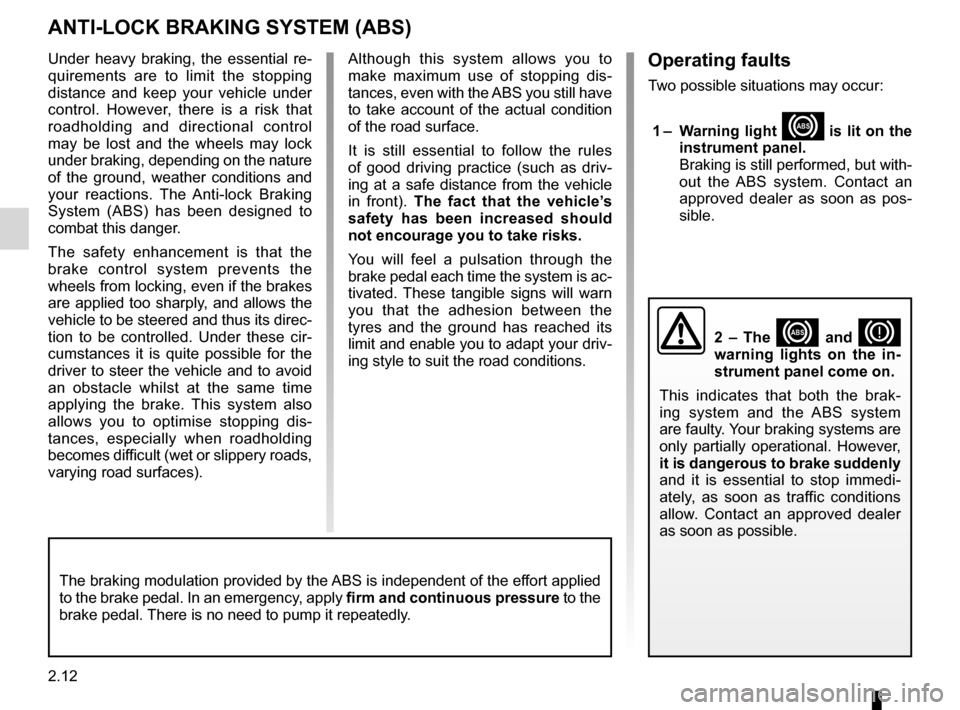
driving ...................................................(up to the end of the DU)ABS ......................................................(up to the end of the DU)anti-lock braking system: ABS ..............(up to the end of the DU)
2.12
ENG_UD5488_1Système antiblocage des routes : ABS (U90 - Dacia)ENG_NU_817-2_NU_Dacia_2
Operating faults
Two possible situations may occur:
1 – Warning light x is lit on the instrument panel.Braking is still performed, but with- out the ABS system. Contact an approved dealer as soon as pos- sible.
Although this system allows you to make maximum use of stopping dis- tances, even with the ABS you still have to take account of the actual condition of the road surface.
It is still essential to follow the rules of good driving practice (such as driv- ing at a safe distance from the vehicle in front). The fact that the vehicle’s safety has been increased should not encourage you to take risks.
You will feel a pulsation through the brake pedal each time the system is ac- tivated. These tangible signs will warn you that the adhesion between the tyres and the ground has reached its limit and enable you to adapt your driv- ing style to suit the road conditions.
2 – The x and D warning lights on the in- strument panel come on.
This indicates that both the brak- ing system and the ABS system are faulty. Your braking systems are only partially operational. However, it is dangerous to brake suddenly and it is essential to stop immedi- ately, as soon as traffic conditions allow. Contact an approved dealer as soon as possible.
Système antiblocage des roues (ABS)
ANTI-LOCK BRAKING SYSTEM (ABS)
Under heavy braking, the essential re- quirements are to limit the stopping distance and keep your vehicle under control. However, there is a risk that roadholding and directional control may be lost and the wheels may lock under braking, depending on the nature of the ground, weather conditions and your reactions. The Anti-lock Braking System (ABS) has been designed to combat this danger.
The safety enhancement is that the brake control system prevents the wheels from locking, even if the brakes are applied too sharply, and allows the vehicle to be steered and thus its direc- tion to be controlled. Under these cir- cumstances it is quite possible for the driver to steer the vehicle and to avoid an obstacle whilst at the same time applying the brake. This system also allows you to optimise stopping dis- tances, especially when roadholding becomes difficult (wet or slippery roads, varying road surfaces).
The braking modulation provided by the ABS is independent of the effort applied to the brake pedal. In an emergency, apply firm and continuous pressure to the brake pedal. There is no need to pump it repeatedly.
Page 94 of 146
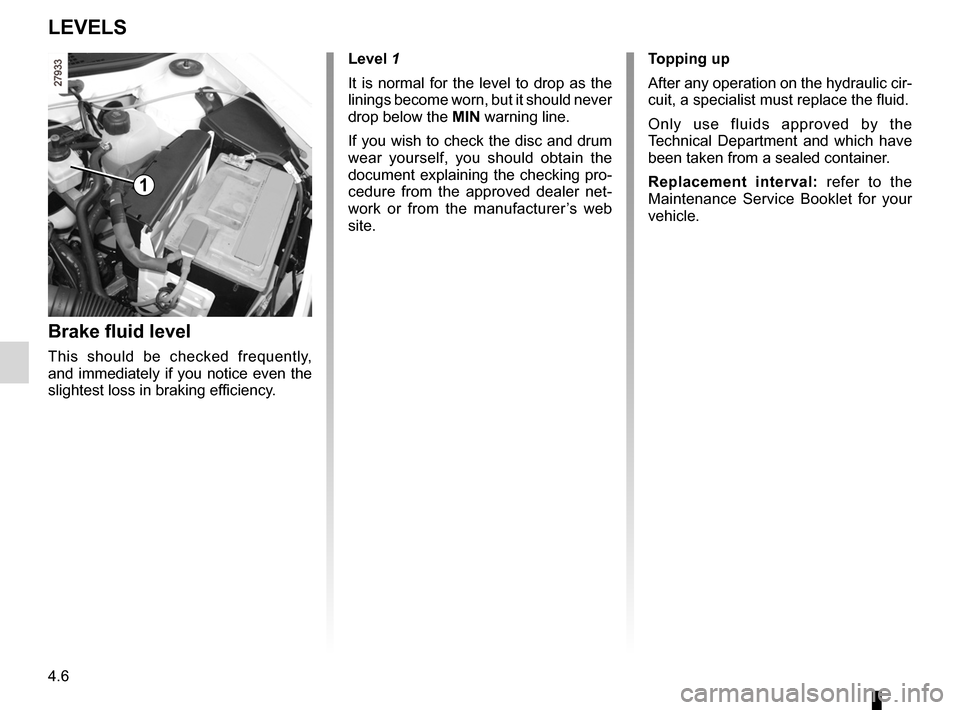
maintenance:mechanical ......................................(up to the end of the DU)brake fluid ..............................................................(current page)levels ....................................................(up to the end of the DU)tanks and reservoirsbrake fluid ........................................................(current page)
4.6
ENG_UD5592_1Niveaux / Filtres (B90 - Dacia)ENG_NU_817-2_NU_Dacia_4
JauneNoirNoir texte
Niveaux : Liquide de freins
LEVELS
Brake fluid level
This should be checked frequently, and immediately if you notice even the slightest loss in braking efficiency. Level
1
It is normal for the level to drop as the linings become worn, but it should never drop below the MIN warning line.
If you wish to check the disc and drum wear yourself, you should obtain the document explaining the checking pro- cedure from the approved dealer net-work or from the manufacturer’s web site.
Topping up
After any operation on the hydraulic cir- cuit, a specialist must replace the fluid.
Only use fluids approved by the Technical Department and which have been taken from a sealed container.
Replacement interval: refer to the Maintenance Service Booklet for your vehicle.
1
Page 106 of 146
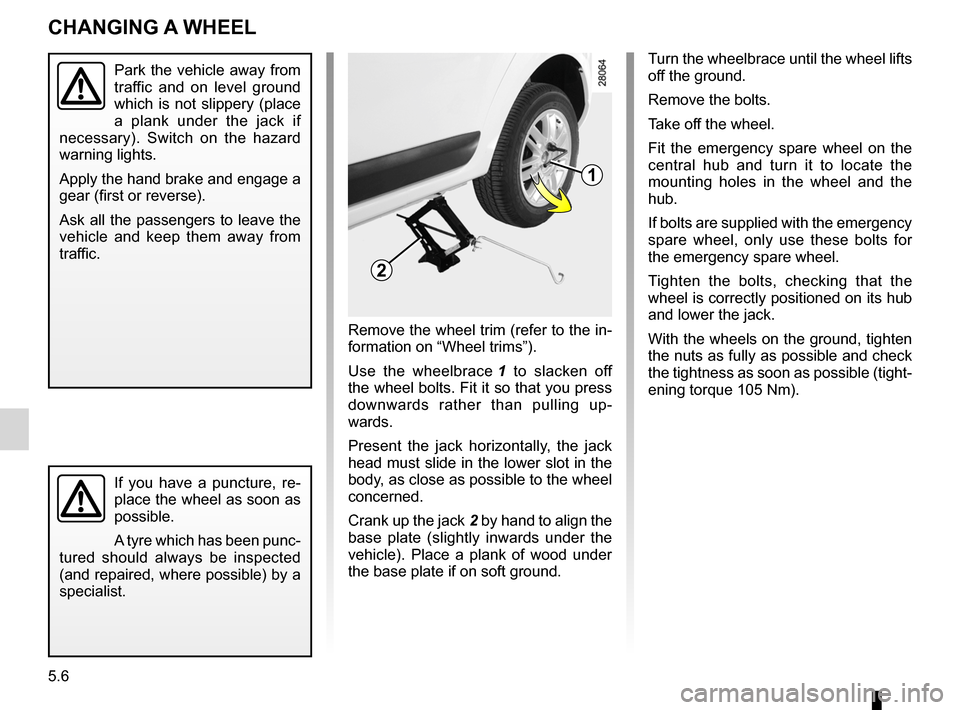
changing a wheel..................................(up to the end of the DU)practical advice .....................................(up to the end of the DU)jack .......................................................(up to the end of the DU)puncture................................................(up to the end of the DU)lifting the vehiclechanging a wheel ............................(up to the end of the DU)
5.6
ENG_UD5600_1Changement de roue (B90 - Dacia)ENG_NU_817-2_NU_Dacia_5
Changement de roue
CHANGING A WHEEL
Park the vehicle away from traffic and on level ground which is not slippery (place a plank under the jack if necessary). Switch on the hazard warning lights.
Apply the hand brake and engage a gear (first or reverse).
Ask all the passengers to leave the vehicle and keep them away from traffic.
If you have a puncture, re-
place the wheel as soon as possible.
A tyre which has been punc- tured should always be inspected (and repaired, where possible) by a specialist.
Remove the wheel trim (refer to the in- formation on “Wheel trims”).
Use the wheelbrace
1 to slacken off the wheel bolts. Fit it so that you press downwards rather than pulling up- wards.
Present the jack horizontally, the jack head must slide in the lower slot in the body, as close as possible to the wheel concerned.
Crank up the jack
2 by hand to align the base plate (slightly inwards under the vehicle). Place a plank of wood under the base plate if on soft ground.
Turn the wheelbrace until the wheel lifts off the ground.
Remove the bolts.
Take off the wheel.
Fit the emergency spare wheel on the central hub and turn it to locate the mounting holes in the wheel and the hub.
If bolts are supplied with the emergency spare wheel, only use these bolts for the emergency spare wheel.
Tighten the bolts, checking that the wheel is correctly positioned on its hub and lower the jack.
With the wheels on the ground, tighten the nuts as fully as possible and check the tightness as soon as possible (tight- ening torque 105 Nm).
1
2
Page 107 of 146
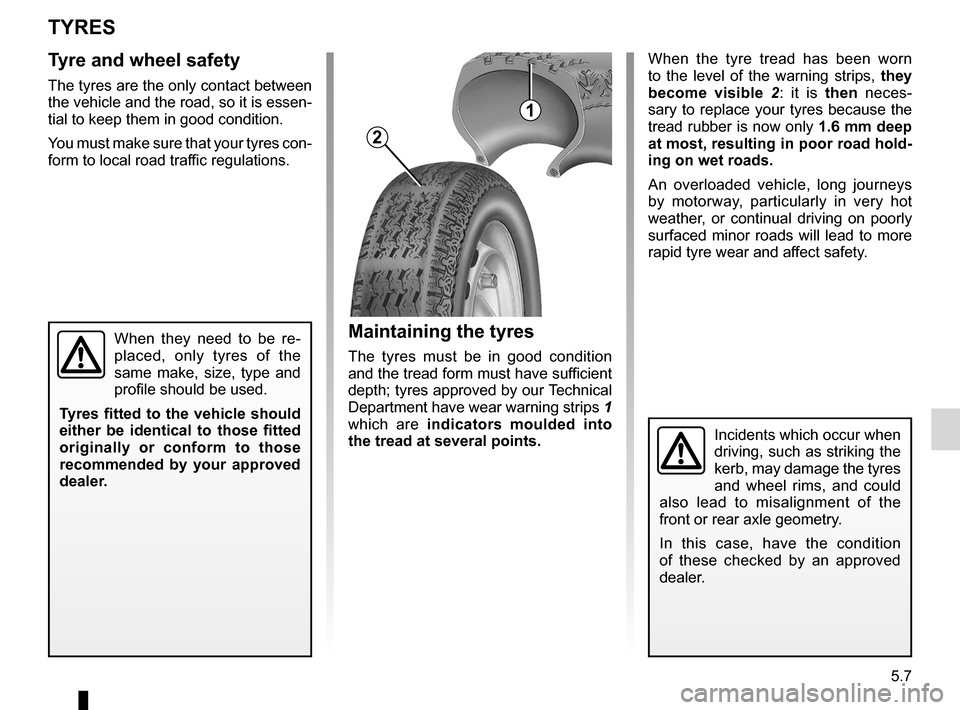
practical advice .....................................(up to the end of the DU)tyres ......................................................(up to the end of the DU)emergency spare wheel .......................(up to the end of the DU)
5.7
ENG_UD5513_1Pneumatiques (U90 - Dacia)ENG_NU_817-2_NU_Dacia_5
Pneumatiques (sécurité pneumatiques, roues, utilisation hivernale\
)
TYRES
Tyre and wheel safety
The tyres are the only contact between the vehicle and the road, so it is essen- tial to keep them in good condition.
You must make sure that your tyres con- form to local road traffic regulations.
When they need to be re- placed, only tyres of the same make, size, type and profile should be used.
Tyres fitted to the vehicle should either be identical to those fitted originally or conform to those recommended by your approved dealer.
Maintaining the tyres
The tyres must be in good condition and the tread form must have sufficient depth; tyres approved by our Technical
Department have wear warning strips 1 which are indicators moulded into the tread at several points.
When the tyre tread has been worn to the level of the warning strips, they become visible 2: it is then neces- sary to replace your tyres because the tread rubber is now only 1.6 mm deep at most, resulting in poor road hold- ing on wet roads.
An overloaded vehicle, long journeys by motorway, particularly in very hot weather, or continual driving on poorly surfaced minor roads will lead to more rapid tyre wear and affect safety.
Incidents which occur when driving, such as striking the kerb, may damage the tyres and wheel rims, and could also lead to misalignment of the front or rear axle geometry.
In this case, have the condition of these checked by an approved dealer.
1
2
Page 130 of 146
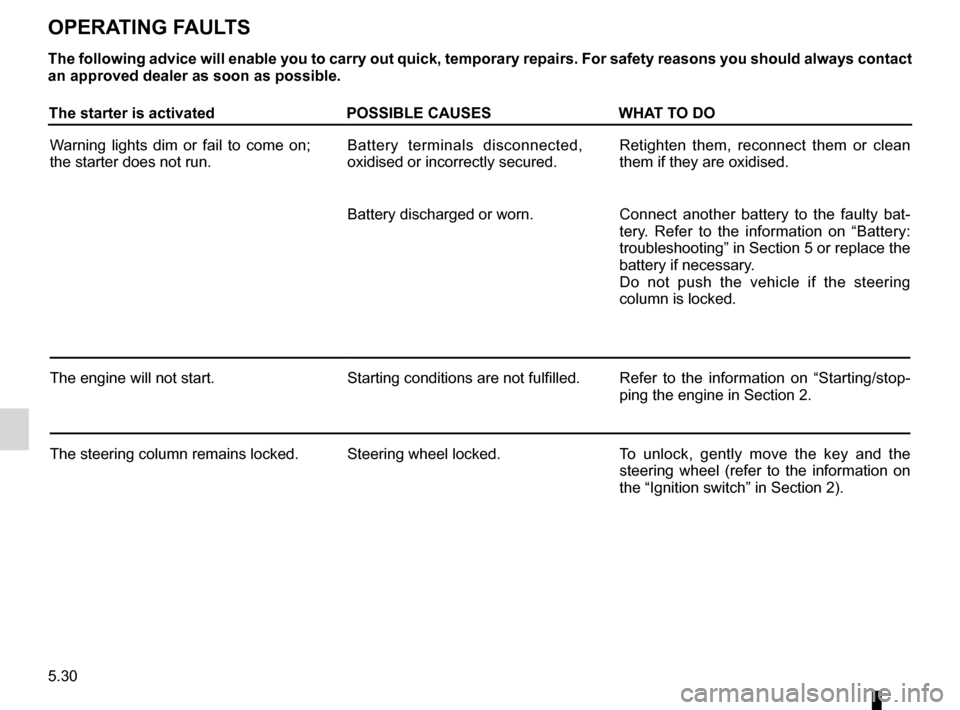
operating faults .....................................(up to the end of the DU)practical advice .....................................(up to the end of the DU)faultsoperating faults ...............................(up to the end of the DU)
5.30
ENG_UD5616_1Anomalies de fonctionnement (B90 - Dacia)ENG_NU_817-2_NU_Dacia_5
JauneNoirNoir texte
Anomalies de fonctionnement
OPERATING FAULTS
The following advice will enable you to carry out quick, temporary repairs. For safety reasons you should always contact an approved dealer as soon as possible.
The starter is activatedPOSSIBLE CAUSESWHAT TO DO
Warning lights dim or fail to come on; the starter does not run.Battery terminals disconnected, oxidised or incorrectly secured.Retighten them, reconnect them or clean them if they are oxidised.
Battery discharged or worn.Connect another battery to the faulty bat- tery. Refer to the information on “Battery: troubleshooting” in Section 5 or replace the battery if necessary.Do not push the vehicle if the steering column is locked.
The engine will not start.Starting conditions are not fulfilled.Refer to the information on “Starting/stop- ping the engine in Section 2.
The steering column remains locked.Steering wheel locked.To unlock, gently move the key and the steering wheel (refer to the information on the “Ignition switch” in Section 2).
Page 131 of 146

JauneNoirNoir texte
5.31
ENG_UD5616_1Anomalies de fonctionnement (B90 - Dacia)ENG_NU_817-2_NU_Dacia_5
OPERATING FAULTS (continued)
On the roadPOSSIBLE CAUSESWHAT TO DO
Vibrations.Tyres not inflated to correct pres- sures, incorrectly balanced or dam- aged.
Check the tyre pressures; if this is not the cause, have their condition checked by an approved dealer.
Abnormal white smoke from the exhaust or coolant boiling in the reservoir.Mechanical fault: cylinder head gasket blown, faulty coolant pump.Stop the engine.Contact an approved dealer.
Smoke under the bonnet.Short circuit or cooling system leak.Stop, switch off the ignition, stand away from the vehicle and contact an approved Dealer.
The oil pressure warning light comes on:
on a bend or under brakingThe level is too low.Top up the engine oil (refer to the informa- tion on “Engine oil level, topping up/refill- ing” in Section 4).
at idle speedLow oil pressure.Go to your nearest approved dealer.
is slow to go out or remains lit up under accelerationLoss of oil pressure.Stop the vehicle: contact a an approved dealer.